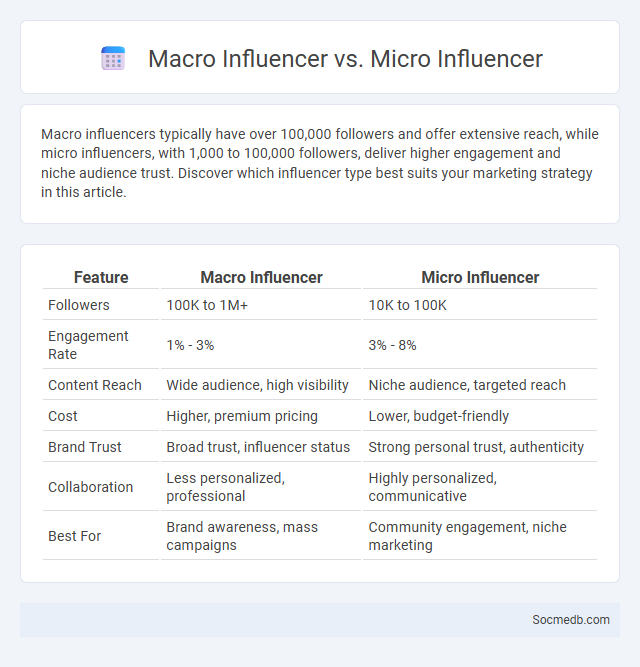
Photo illustration: Macro Influencer vs Micro Influencer
Macro influencers typically have over 100,000 followers and offer extensive reach, while micro influencers, with 1,000 to 100,000 followers, deliver higher engagement and niche audience trust. Discover which influencer type best suits your marketing strategy in this article.
Table of Comparison
| Feature | Macro Influencer | Micro Influencer |
|---|---|---|
| Followers | 100K to 1M+ | 10K to 100K |
| Engagement Rate | 1% - 3% | 3% - 8% |
| Content Reach | Wide audience, high visibility | Niche audience, targeted reach |
| Cost | Higher, premium pricing | Lower, budget-friendly |
| Brand Trust | Broad trust, influencer status | Strong personal trust, authenticity |
| Collaboration | Less personalized, professional | Highly personalized, communicative |
| Best For | Brand awareness, mass campaigns | Community engagement, niche marketing |
Understanding Influencer Tiers: Macro, Micro, and Influencer Defined
Understanding influencer tiers is crucial for effective social media marketing, with macro influencers typically having over 100,000 followers and broad brand reach, while micro influencers possess 10,000 to 100,000 followers and often engage more deeply with niche audiences. Influencers wield significant power in shaping consumer behavior by blending authentic content with strategic brand partnerships. Your marketing strategy benefits when selecting the right influencer tier to match your campaign goals, budget, and target audience.
Reach and Audience Size: How Do Levels Compare?
Social media platforms vary significantly in reach and audience size, with giants like Facebook boasting over 2.9 billion monthly active users, while niche platforms cater to smaller, more targeted communities. Your choice of platform should align with where your ideal audience spends their time, as reaching a larger, general audience can increase visibility but may dilute engagement compared to focused, niche groups. Analyzing demographics and user behavior on platforms like Instagram, TikTok, LinkedIn, and Twitter helps optimize your strategy to maximize impact and grow your social media presence effectively.
Engagement Rates: Macro vs Micro vs Traditional Influencers
Engagement rates vary significantly among macro, micro, and traditional influencers, with micro-influencers often delivering higher interaction percentages due to their niche audiences and authentic connections. Traditional influencers, while having broader reach, typically experience lower engagement rates compared to micro and some macro influencers who balance reach and relatability. Understanding these differences helps you optimize your social media strategy by selecting influencers whose engagement rates align with your campaign goals.
Cost and ROI: Analyzing Influencer Marketing Budgets
Influencer marketing budgets vary widely depending on niche, influencer reach, and campaign goals, often ranging from a few hundred to several thousand dollars per post. Analyzing your ROI involves tracking engagement rates, conversion metrics, and long-term brand loyalty generated by influencer collaborations. Investing strategically in influencers aligned with your target audience can maximize your cost-efficiency and overall marketing impact.
Brand Affinity: Finding the Best Fit for Campaign Goals
Social media platforms offer diverse tools to enhance brand affinity by aligning content with your target audience's interests and behaviors. Selecting the right platform, whether Instagram for visual storytelling or LinkedIn for B2B connections, optimizes engagement and strengthens emotional connections. Your campaign goals are best served by analyzing platform demographics and engagement metrics to ensure maximum resonance and loyalty.
Content Authenticity and Audience Trust
Content authenticity on social media is paramount for building and maintaining audience trust, as users increasingly seek reliable and transparent information. Platforms are implementing advanced verification technologies and metadata tracking to combat misinformation and ensure content credibility. Establishing genuine interactions and providing accurate, verifiable content enhances user engagement and loyalty in the competitive digital landscape.
Platform Presence: Where Each Influencer Shines
Influencers dominate various social media platforms based on their niche and content style, with Instagram excelling in fashion and lifestyle visuals, TikTok leading in short-form, viral video content, and YouTube providing long-form, in-depth tutorials and vlogs. LinkedIn serves professionals and industry experts, fostering thought leadership and B2B networking, while Twitter remains a hub for real-time conversations, news, and microblogging. Each platform's unique algorithm and audience demographics dictate where influencers garner maximum engagement and brand partnerships.
Collaboration Strategies for Macro and Micro Influencers
Collaboration strategies for macro and micro influencers emphasize leveraging complementary strengths, where macro influencers provide extensive reach and micro influencers offer higher engagement and niche audience trust. Brands optimize campaigns by combining macro influencers' broad visibility with micro influencers' authentic content, boosting overall effectiveness and ROI. Data-driven targeting and coordinated content calendars enhance synergy, ensuring consistent messaging and maximum audience impact across social media platforms.
Measuring Success: KPIs and Analytics by Influencer Type
Measuring success on social media requires tracking Key Performance Indicators (KPIs) such as engagement rate, follower growth, and conversion metrics tailored to each influencer type--macro, micro, or nano. Your analytics should focus on metrics that align with the influencer's audience size and niche relevance, ensuring that you capture authentic interactions and brand impact. Leveraging tools like UTM parameters and sentiment analysis helps quantify ROI and optimize campaign strategies according to influencer-specific performance data.
Choosing the Right Influencer for Your Brand
Selecting the right influencer for your brand involves analyzing their audience demographics, engagement rates, and content alignment with your brand values. Researching influencers with authentic followers and a proven track record of promoting similar products ensures effective reach and higher ROI. Your choice impacts brand credibility and drives meaningful connections with potential customers.
 socmedb.com
socmedb.com